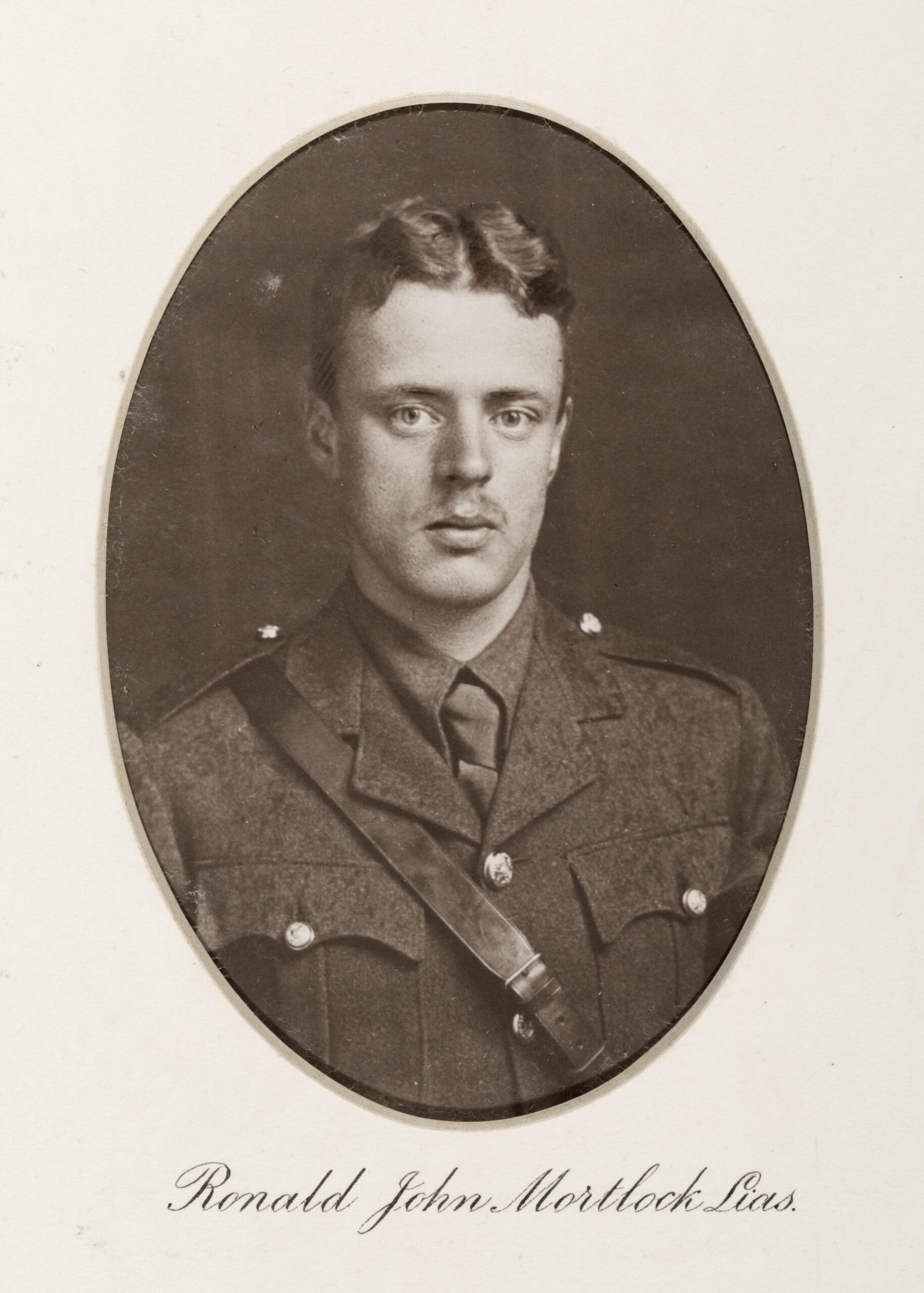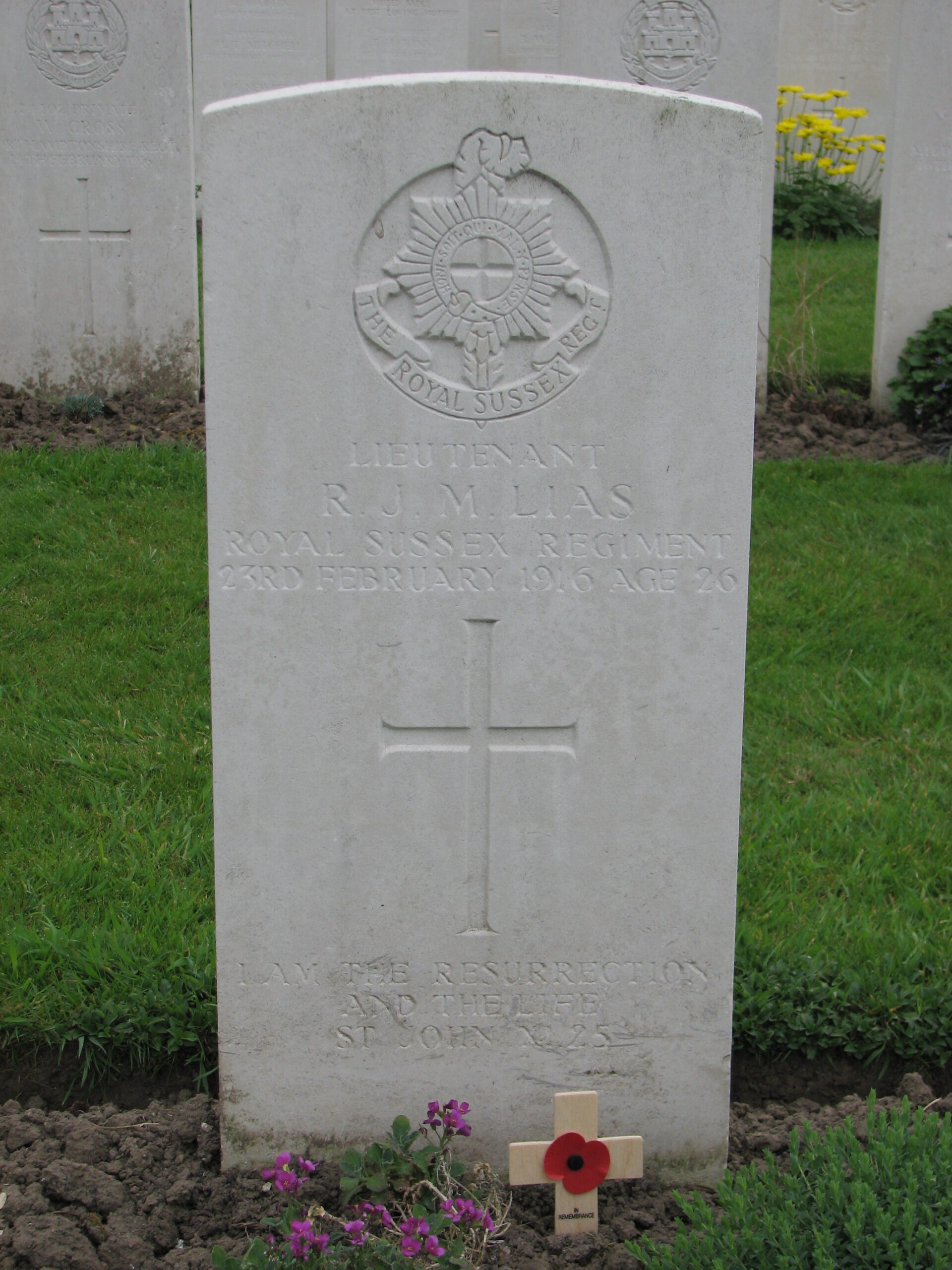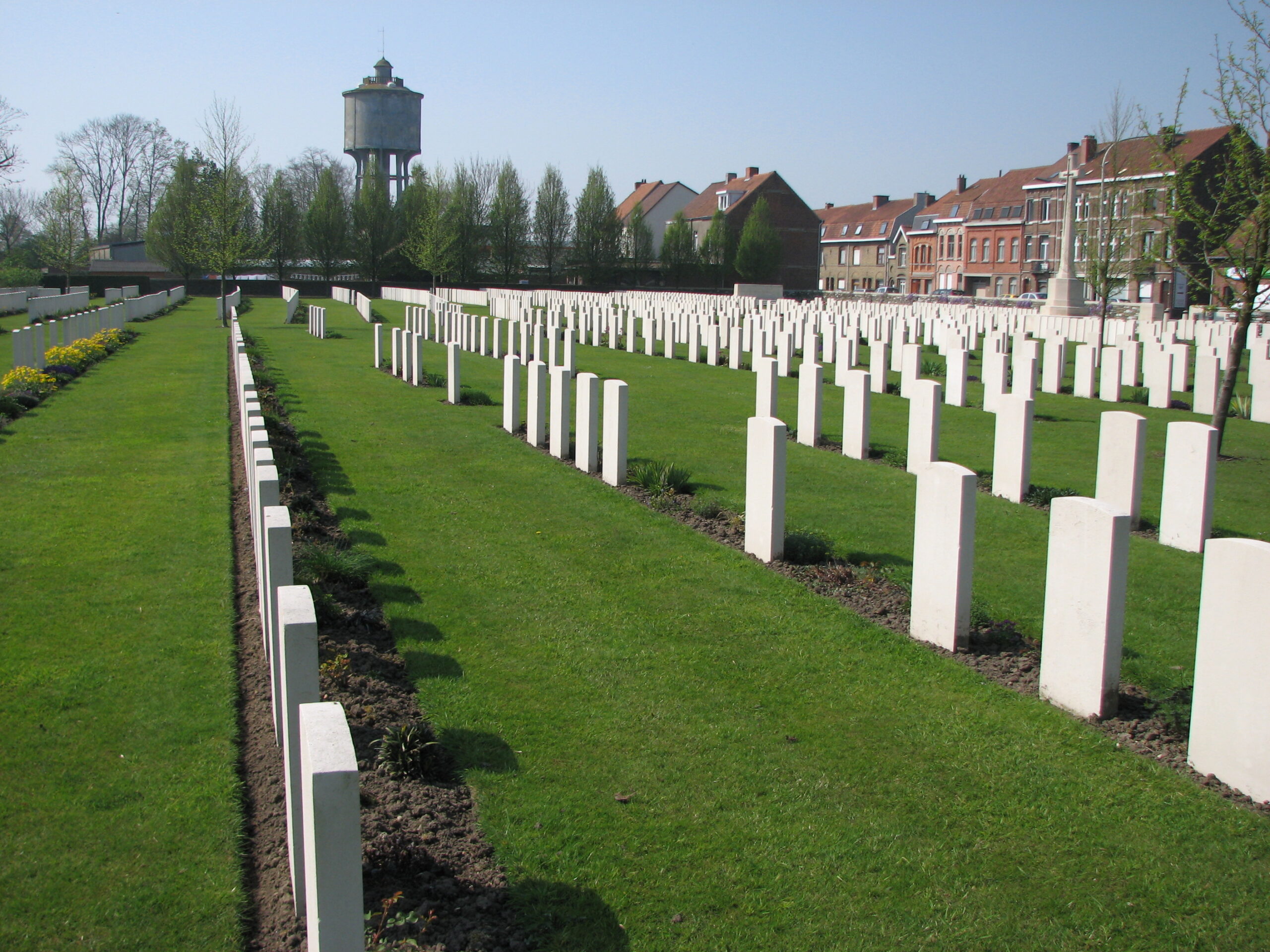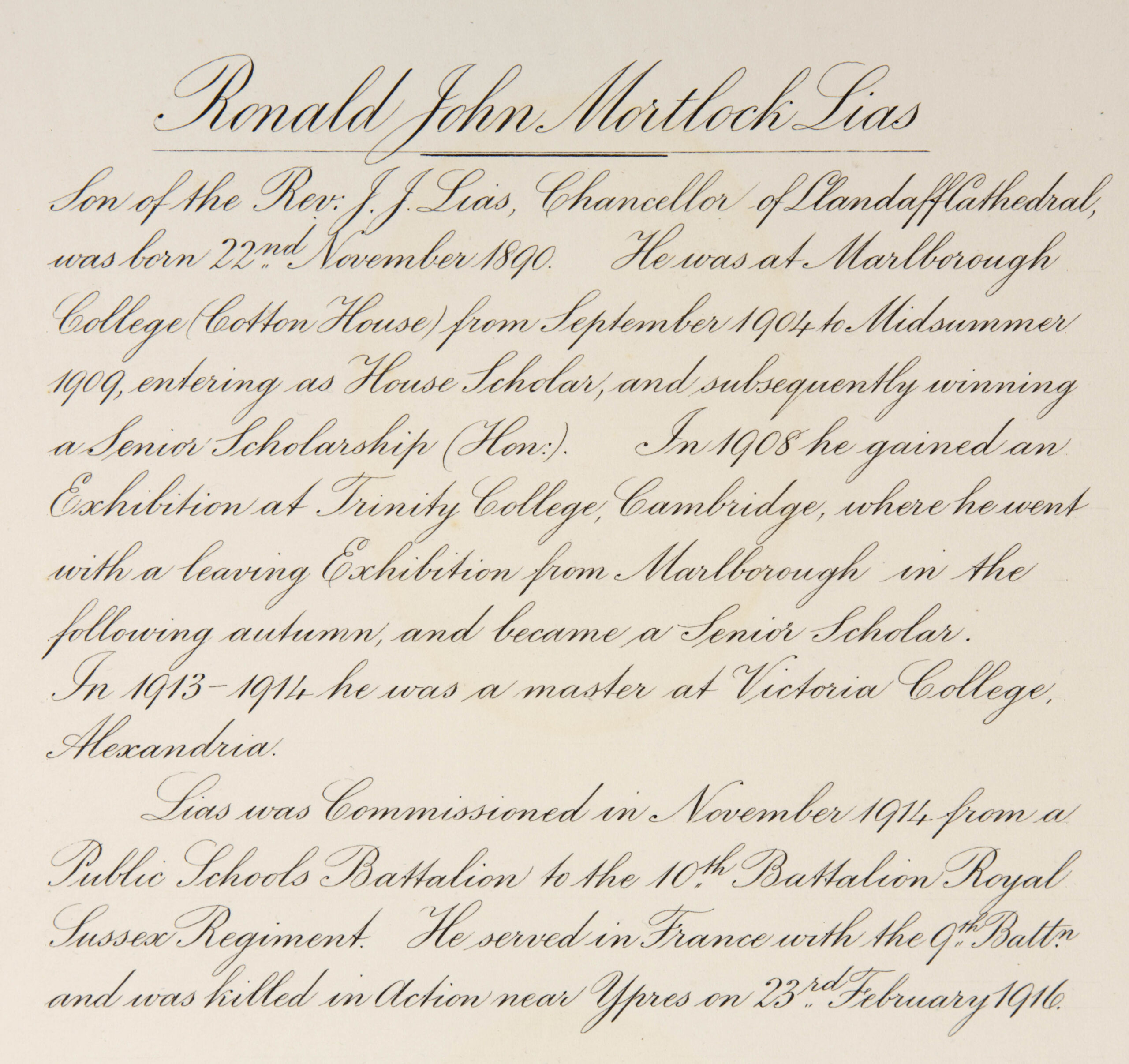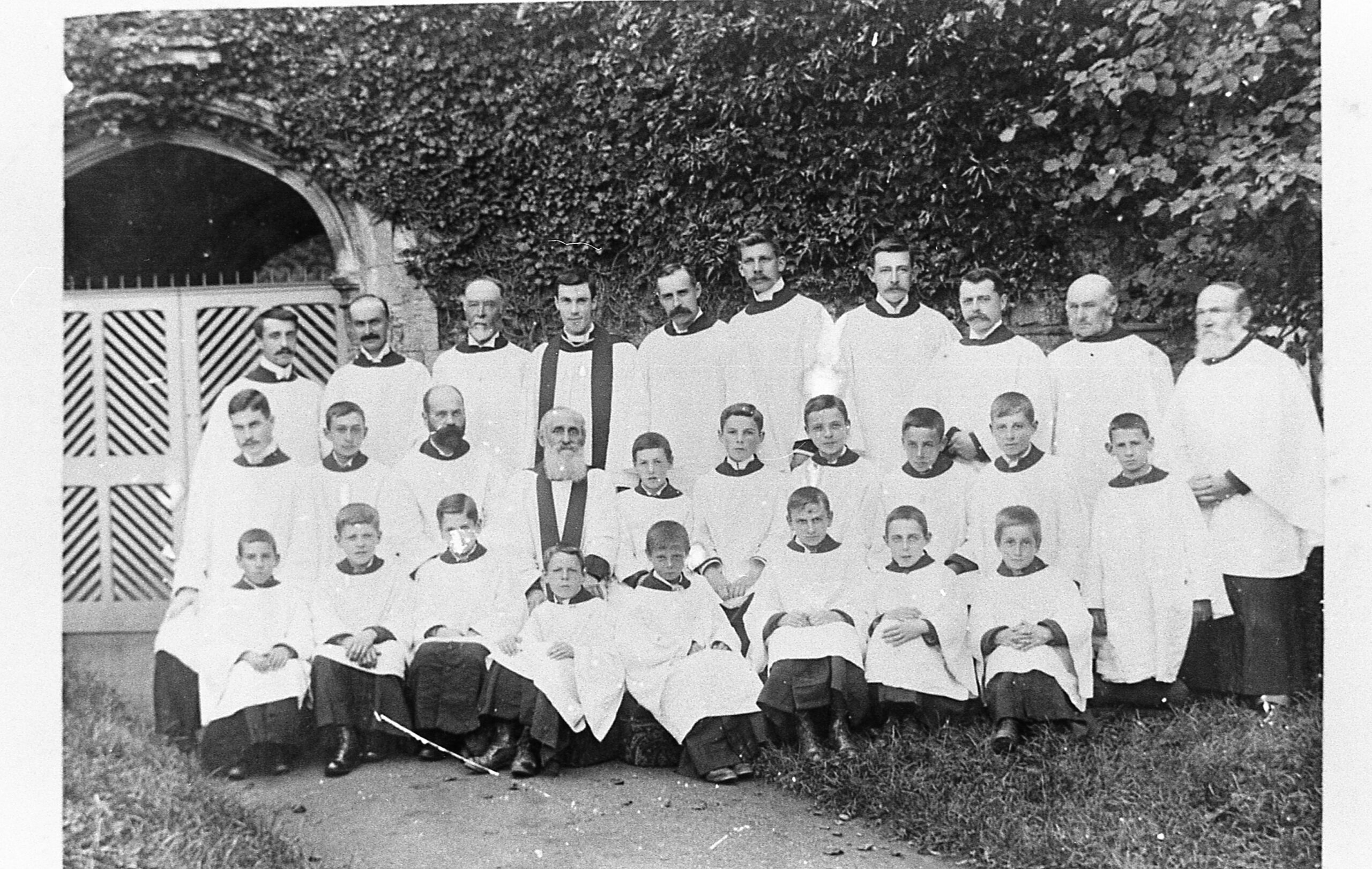Ronald Lias (1890 - 1916)
The son of the Rev. J.J. Lias who had been St. Mary’s Rector between 1892 and 1903, Ronald was Cambridge Graduate who joined the Army shortly after the outbreak of war. He was killed in the Ypres Salient in 1916.
- 42
- Died in the Great War
- 51.96998, 1.020778
Details
| Name: | Ronald John Mortlock Lias |
| Service: | British Army |
| Unit: | 9th Battalion, Royal Sussex Regiment |
| Rank: | Lieutenant |
| Date of Death: | 23rd February 1916 |
| Age: | 25 |
| Buried: | Plot I, Row I, Grave 5, Menin Road South Military Cemetery, Ieper (Ypres), Belgium |
In his 1923 book, “East Bergholt in Suffolk”, the village’s Rector wrote “On our Roll of Honour appears the name of Ronald Lias. Though he did not join the Army from here, yet we felt it proper to include him as one of those honoured in the parish where his father had been rector, and he himself had lived when a boy”. 1 East Bergholt in Suffolk” by T.F. Peterson M.A., Rector. Printed for private circulation by W. Lewis University Press, Cambridge, 1923.
Family Background and Early Life
Ronald Lias was born on 22nd November 1890 at St Mary’s Gate in Cambridge, the first of three children from the marriage of Reverend John James Lias, and his wife Mary.
At the time of Ronald’s birth, his father was the vicar of St. Edward’s in Cambridge, and also held the appointment of Examining Chaplain to the Bishop of Llandaff, near Cardiff. 2 John Lias (1824 – 1923) had been ordained in 1858, and his first appointment was to the curacy of Shaftesbury in Dorset. An ecclesiastical scholar, he was also appointed as Chancelleor of Llandaff Cathedral. The Reverend Lias was Rector of East Bergholt from 1892 until his retirement in 1903. John Lias’ first wife Edith, who had borne him 6 children, had died in 1887. Three years later, the 55 year old John married Mary Blanche Mortlock, who was the 29 year old daughter of a Banker, from Cambridge.
In 1892, the Reverend Lias was appointed as the Rector of East Bergholt, a post he would hold for the next 11 years. The family lived in The Rectory (which is now called The Old Rectory) located at Burnt Oak. At that time, the property was accessed from Gandish Road – where Gandish Close is now situated.
Like most young men of his class, Ronald was sent away to Boarding School to be educated. Between 1904 and 1909 he attended Marlborough College in Wiltshire, entering as a House Scholar and later winning a Senior Scholarship. This independent school had originally been founded in 1843 for the sons of Church of England Clergy. Whilst he was there, Ronald also spent 3 years in the Officer Training Corps.
In 1909, Ronald went up to Cambridge University, where he became a student at Trinity College. He left there in 1912, with a First Class Honours degree in the Classics.
After graduating, Ronald started studying for Holy Orders, and was also for a short time a Master at the Victoria School in Alexandria, Egypt. 3 Charles Lias (Ronald’s half-brother) was the School’s headmaster. This was a private school first founded in 1902, and has been described as providing “an English public school education that was at last within easy reach of Middle Easterners.” 4 From “Victoria College: a model to replicate” by Zaid M. Belbagi, found in “Arab News”, 15 June 2017.
Joins the Army
By September 1914, Ronald was back in the United Kingdom and residing with his parents at Hayward’s Heath in Sussex. On the 11th of that month, he applied for a Commission as an Officer in the Infantry. Six days later he enlisted as a Private in the Public Schools Battalion of the Middlesex Regiment.
Ronald’s surviving Service Papers from his enlistment state that he was 5 foot 9 inches tall, weighed 140 lb and had light brown hair, dark blue eyes and a fair complexion.
Ronald was only with the Middlesex for a short time, for on 8th October he was commissioned as a 2nd Lieutenant in the Sussex Regiment and was posted to its 10th Battalion. 5 The 10th Battalion of the Sussex Regiment was one of those units created in response to the large numbers of volunteers who flock to the colours in response to Lord Kitchener’s call for volunteers.
The 10th was formed at Dover in October 1914, and remained there until April 1915 when it moved to Colchester. Whether Ronald visited his childhood home of East Bergholt, whilst he was stationed at Colchester is not known. In December 1914, whilst he was with the 10th, Ronald was promoted to the rank of Lieutenant.
France and Belgium
Ronald disembarked in France on 8th October 1915, and exactly one month later joined the Regiment’s 9th Battalion “in the trenches”, south of the Belgian town of Ypres. 6 The 9th Sussex was another battalion specifically raised for service in the Great War. It had arrived in France on 1st September 1915, and within weeks of its arrival was thrown into the Battle of Loos, where it suffered heavy losses. Ronald joined them shortly afterwards.
The 9th Sussex were relieved by another battalion 4 days later and rotated back to billets before returning to the trenches for another 5 day tour of duty on the 17th.
The battalion was relieved on Ronald’s birthday and spent most of the next month and a half at a camp in Houlle, 35 miles behind the lines. There, they were kept occupied with drill, training and route marches.
The Battalion were back in the trenches for another 5 day tour on 18th January, this time to the east of Ypres – in the vicinity of Sanctuary Wood.
For many of the men who served in the Great War, the rigours of active service – often in cold, wet and unsanitary conditions – made them more susceptible to disease and illness. In late January 1916, Ronald was admitted to Number 14 General Hospital, located on the Channel coast in the village of Wimereux, near Boulogne, suffering from influenza.
Hooge
Ronald was discharged to duty on 10th February, and joined the Battalion in the trenches to the north of the Menin Road, near the village of Hooge. On the 13th, the Battalion were subjected to a very heavy, 8 1/2 hour long artillery bombardment. A great deal of damage was done to the front line trenches. By the time they came out of the firing and support lines two days later, that particular tour had cost the Battalion 139 casualties.
The 9th Royal Sussex went back to the cellars in Ypres, for a day of rest followed by two days of working parties. They returned to the same section of front line trenches on 19th February.
The Battalion’s War Diary states that 23rd February 1916 was a quiet day. The weather was described as wet, but with a hard frost. However, that morning Ronald was killed – possibly by a German sniper. 7 The only source in the public domain that states Ronald was killed by a sniper is the Royal Sussex Regiment website. No further detail is provided about where exactly this information came from
At the time of his death, Ronald had been in command of the Battalion’s “B”Company. The Battalion’s Commanding Officer wrote “Lieut. Lias was one of my smartest officers; his death was indeed a great loss to the 9th Royal Sussex”. 8 From “De Ruvigny’s Roll of Honour 1914 – 1918”.
Ronald was buried in a military cemetery by the south side of the Menin Road, on the outskirts of Ypres. Now called the Menin Road South Military Cemetery, 1,657 servicemen of the Great War are either buried or commemorated there. 9 Ronald’s younger brother Thomas also served in the Great War as a Sapper in the Royal Engineers. Thomas survived the War, and is commemorated on the Roll of Honour listing the names of all those from East Bergholt who served in the Armed Forces during that conflict.
Acknowledgements
I am very grateful to Marlborough College, Wiltshire, for kindly allowing me to include the photograph of Ronald which is held in their Roll of Honour and the attaching Citation. Their Roll of Honour has been digitised and can now be accessed via their Archives website.
Copyright © Mark Ashmore, 2024
- 42
- Died in the Great War
- 51.96998, 1.020778

